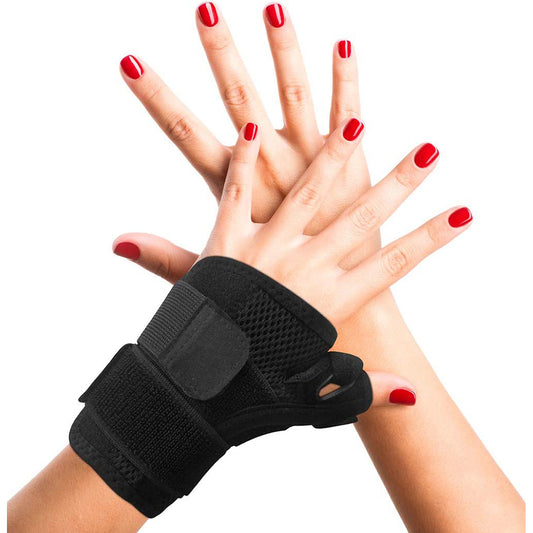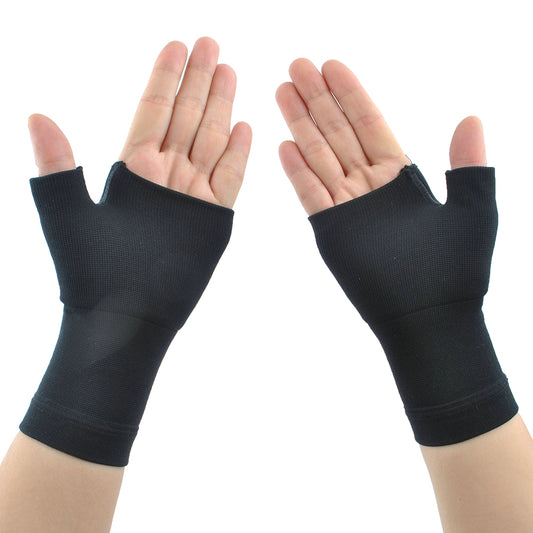-
Thumb Brace - Thumb Spica Splint for Arthritis, Tendonitis and More. Fits Both Right Hand and Left Hand for Men and Women. Trigger Thumb Support Braces
Regular price $22.00 USDRegular price$32.00 USDSale price $22.00 USDSale -
Compression Wrist Support - Wrist Sleeve for Wrist Pain, Carpal Tunnel - Wrist Brace
Regular price $18.99 USDRegular price$26.99 USDSale price $18.99 USDSale -
Wrist and Thumb Support - Compression Hand Sleeves- Lightweight, Breathable- Relieve Strains, Sprains, Instability, Arthritic Wrists
Regular price $18.99 USDRegular price$18.99 USDSale price $18.99 USD
Collection: Thumb Support : Alleviating Pain from Arthritis, Tendinitis, and Injuries
Enhance Thumb Mobility and Relieve Pain with Our Thumb Support Products
The thumb, often underestimated for its size, plays a pivotal role in our daily lives. At ZSZBACE, we understand the importance of optimal thumb health. This is why we offer a wide array of thumb splints designed to aid in the treatment of various thumb injuries and conditions. Whether you're dealing with arthritis, tendinitis, or a sports-related injury, our comprehensive thumb support collection can provide the relief and support you need.
Who Needs Thumb Support Products?
- Athletes and sports enthusiasts: Individuals involved in sports like tennis, golf, or bowling are prone to thumb injuries such as sprains and strains.
- Mothers and caregivers: Overuse injuries like de Quervain syndrome, often termed “mother's thumb”, commonly occur among new parents due to repetitive wrist and thumb motions.
- Professionals and office workers: Prolonged use of computers and smartphones can result in repetitive strain injuries (RSIs) affecting the thumb and wrist.
- Individuals with existing thumb conditions: Those suffering from conditions like arthritis, carpal tunnel, or tendinitis can benefit from added support and pain relief.
Why Choose Our Thumb Splints and Braces?
Our thumb support products are crafted from high-quality materials and are backed by years of manufacturing and research experience. ZSZBACE offers reliable, professionally endorsed solutions designed to:
- Relieve pain and discomfort associated with thumb conditions
- Provide immobilization and support to promote healing
- Prevent further injuries and strain
We pride ourselves on excellent customer service and after-sales support, ensuring that every customer finds the perfect product for their needs.
How to Tell if You Need a Thumb Support Product
- Pain and discomfort: Persistent or recurring thumb pain may indicate the need for support.
- Reduced mobility: Difficulty in performing usual thumb movements could suggest tendon or ligament issues.
- Swelling and deformity: These symptoms, especially after an injury, often require splinting.
- Numbness or tingling: Common indicators of nerve compressions like carpal tunnel syndrome.
Characteristics of Our Thumb Support Products
- Adjustable fit: Our Thumb Brace - Thumb Spica Splint for Arthritic and Tendonitis Relief is designed to accommodate both the right and left hand and fits comfortably for extended wear.
- Breathable materials: Our products are made with lightweight, breathable materials to ensure comfort during healing.
- Durability: Ideal for everyday use, providing long-lasting support.

Common Questions About Thumb Support Use
-
Will wearing a splint restrict my thumb too much? Our designs aim to balance immobility and ease of use, supporting healing while maintaining necessary thumb functions.
-
Can I use a thumb brace if I play sports? Yes, our Compression Wrist Support - Wrist Sleeve for Wrist Pain and Carpal Tunnel Relief provides stability without hindering performance.
-
How do I care for my thumb splint? Maintain hygiene by regular cleaning with mild soap and water. Ensure the splint dries completely before reuse.
Improvement Benefits of Using Our Thumb Products
- Pain Reduction: Our products alleviate pressure on affected areas, helping to reduce pain and facilitate recovery.
- Enhanced Mobility: Regular use can lead to improved range of motion and strength over time.
- Prevention of Future Issues: By supporting the thumb properly, you can prevent further strain or injury.
Our Wrist and Thumb Support - Lightweight, Breathable Hand Sleeves are designed for comfort and efficiency, making them the perfect choice for managing and improving thumb conditions.

Whether for everyday tasks, sports activities, or post-surgery recovery, ZSZBACE thumb support solutions provide the care and reliability you need to maintain a healthy lifestyle. Explore our collection today and empower your thumb's journey to recovery.



